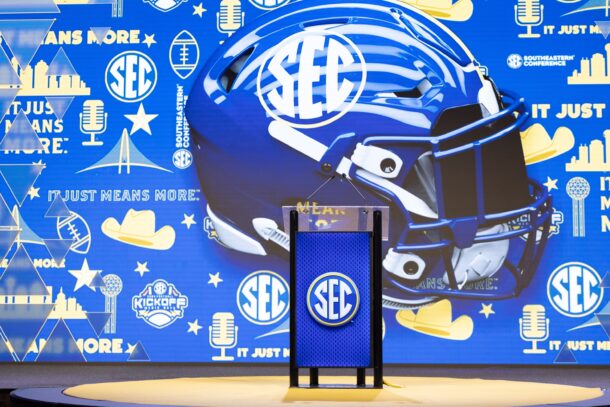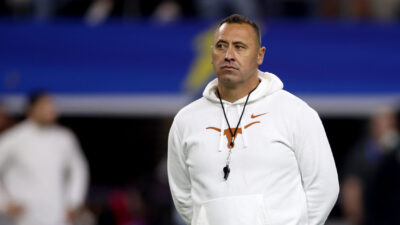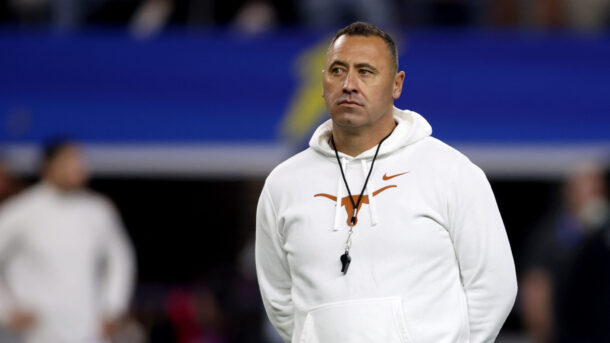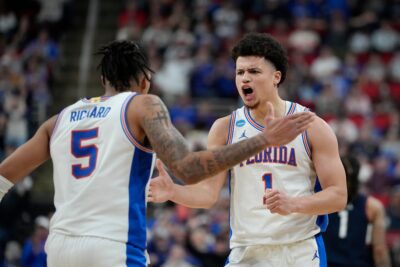Ad Disclosure
There was once a time when fullback was one of the most important positions on the field; now it’s a shock to even see a fullback on the field, at least at the NFL level.
But two former SEC stars who have kept the position alive throughout their young careers — Alabama’s Jalston Fowler and LSU’s Connor Neighbors — will hope to do the same at football’s highest level following this year’s NFL draft.
Fowler is the highest-rated fullback on nearly every draft board due to his versatility at the position and his days as a former tailback eventually converted to an upback. Many peg him in the neighborhood of the fifth round (that’s obviously not an exact science), and nearly every draft expert expects Fowler to be drafted at some point on the third day of the draft (rounds 4-7).
But what makes Fowler such an appealing prospect at the fullback position are all the things he can do that prototypical fullbacks in the past haven’t had to do. He’s physical at the point of attack and is strong enough to knock linebackers off course when serving as a lead blocker or pass protector in the backfield. That’s a standard responsibility for a fullback and has been since the game’s earliest days.
But he can also carry the ball as a short-yardage option who always falls forward and is capable of earning tough yards between the tackles. Not to mention, he’s as capable a pass-catcher as any back, tailback or fullback, in the draft, and he’s a nightmare in play-action situations as a result.
The emergence of spread offenses at the professional level has somewhat eradicated the fullback position, but because Fowler can catch passes and pass protect, he can work his way into more packages within a given offense than many of the other fullbacks in the draft class.
Scouts have reported that Fowler must use his hands more in blocking and must rely less on the power he can generate by simply lowering his shoulder. But no draft prospect, not even the class’ best, is ever perfect upon entering the NFL. Coaches can teach Fowler better form when blocking; what they can’t teach is his power as a blocker, his intensity, his subtle shiftiness at his size with the ball in his hands, and his willingness to fill any role to benefit the unit. Those intangibles are what lead a player at a dying position to new life in the pros.
The perfect measuring stick for Fowler is Green Bay Packers fullback John Kuhn. Green Bay and league MVP Aaron Rodgers have thrived in running a spread offense through the years, but Kuhn has become a fan favorite by handling Green Bay’s dirty work on that side of the ball. In awkward short-yardage situations, he powers forward to pick up first downs for an offense that would rather attack on the perimeter. When Eddie Lacy is rolling, it’s often because Kuhn is helping pave the way, and once Lacy really gets hot, it’s Kuhn who catches balls in the flat to keep defenses honest.
Last year, Kuhn amassed only 108 yards from scrimmage and scored only one touchdown. But ask Green Bay, and he did a whole lot more than those numbers indicate.
Nick Saban, Lane Kiffin and the Alabama coaching staff would gladly say the same of Fowler, who posted 198 yards from scrimmage and two touchdowns as a senior in 2014. All Kuhn, and soon enough Fowler, need to do at the NFL level is present threats as a runner, receiver and lead blocker. Kuhn has clearly done so during his 10-year NFL career, and Fowler fits the exact same mold as a draft prospect.
Neighbors will hope to join Fowler in the NFL next season, but he will have to follow a much different path. It’s iffy as to whether he’ll even be drafted, and if he is it’ll likely be in the final round. He has a high football IQ and has worked with a number of tailbacks at LSU who have NFL futures of their own (like Jeremy Hill, Alfred Blue and Leonard Fournette). He’s always leading his runners to the right place, and he can diagnose opposing defenses at the line as well as any non-quarterback out there.
Unfortunately, unlike Fowler, who stands 5-foot-11 and weighs 255 pounds, Neighbors is a bit smaller, standing the same 5-foot-11 but weighing in at only 229 pounds. He’s less capable of knocking opposing linebackers off point at the NFL level, and while he’ll often ensure he’s in the right place at the right time, he may be simply too small to make an impact in the pros.
For his LSU career he carried the ball three times for five yards in three seasons, eliminating one threat that Fowler can pose at the next level. He caught 11 passes for 119 yards in those three years, and he could be a nice pass-catcher out of the backfield in the NFL, but he’ll also be much easier for opponents to track down than Fowler, who runs with power downhill but has some elusiveness about him.
He’s likely to get a shot at an NFL training camp, but he’s not even regarded as the No. 2 fullback in the class behind Fowler. (Players who hail from the likes of South Dakota State and Yale rank ahead of Neighbors in most prospect rankings.)
Fowler will certainly try and revive the new-age fullback in the NFL; Neighbors would of course love nothing more than to do the same. It’s not as important as it once was, and it’s not played the same as it once was, but there’s a chance fullback can work its way back into NFL offenses.
Maybe they’ll just call it “retro.”
A former newspaper reporter who has roamed the southeastern United States for years covering football and eating way too many barbecue ribs, if there is such a thing.




